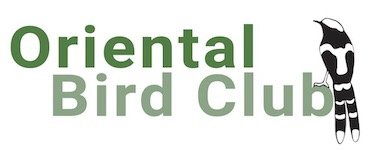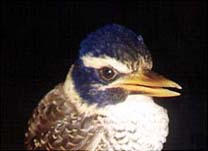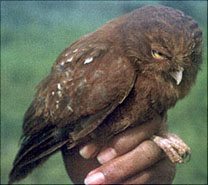Birdwatching Areas: Gunung Ambang Nature Reserve, North Sulawesi
by Jon Riley, from OBC Bulletin 32, December 2000.
The Indonesian island of Sulawesi, lying at the heart of Wallacea, is famous for its unique array of species: at least 88 bird species are found nowhere else in the world. The majority of these endemics are restricted to the island's montane areas and has become familiar to birdwatchers visiting the impressive Lore Lindu National Park in central Sulawesi (1-3). However, away from Lore Lindu, many mountain ranges remain little explored.
A chain of mountains runs along almost the entire length of the northern peninsula of Sulawesi. In the west this forms the Tentolo-Matinan range and reaches heights of over 2,000 m, whilst to the east the huge Bogani Nani Wartabone (Dumoga Bone) National Park includes extensive areas of montane forest. The only recent surveys of these mountains revealed a diverse avifauna with many exciting endemics (4).
To the east of the national park lies the small - 8,000 ha - Cagar Alam (Nature Reserve) Gunung Ambang. Like many reserves throughout Indonesia, Ambang has not been surveyed in detail and the biological diversity it supports has yet to be adequately documented. In November 1999 I led a team of scientists from the Wildlife Conservation Society - Indonesia Program in Sulawesi on the first in-depth surveys to be conducted at the reserve. These led to the discovery of two of Sulawesi's threatened endemics - Matinan Flycatcher Cyornis sanfordi and the recently described Cinnabar Hawk Owl Ninox ios (5). We also found that the reserve was an excellent birding site, easy to reach from the provincial town of Kotamobagu, and a visit to Ambang could be combined with a stay at the Toraut research station at Dumoga Bone, already a popular location with birders. Below I provide details of access, accommodation, and the more interesting species.
Scaly Kingfisher © Jon Riley
Access and accommodation
The reserve is under the administration of the National Park office in Kotamobagu and birders must obtain permits from here; the office is out of town in Mongkonai (get a mikrolet - blue minibus) on Jalan AKD, telephone 0434-22548. Kotamobagu is served by buses from Manado (where there is an airport with international and domestic flights) and Gorontalo (for people arriving from Palu/Lore Lindu).
Birders visiting Ambang will have to be accompanied by a ranger - not only is this advisable given the area's remoteness, but rangers can also assist with language and organising food/accommodation close to the site. Daily rates are usually between US$3 and US$5. These rangers are used to the demands of birders - such as early starts - and know their birds; check at the park office.
Access to the best birding areas is from the village of Singsingon, located at a chilly 1000 m. The village can be reached by a crowded public bus - one hour - from the centre of Kotamobagu or alternatively one can charter a bus direct to the village for a more comfortable ride; expect to pay about US$5. Ask the park office for help.
There is no official accommodation in Singsingon but visiting birders can stay in the nature reserve guard post at the edge of the village. The post has running water and electricity, but no beds (at November 1999) and visitors need to bring camping mats or similar. Accommodation can also be sought in Singsingon village with a local family - contact Yulius Domingus (Yus) the local park guard. There are some food stalls operating at night, but for US$2 or US$3 per person per day Yus can arrange for food to be prepared for you. This will be simple - rice and fish - so it's a good idea to shop in Kotamobagu.
Cinnabar Hawk Owl © Jon Riley
The footpath to the reserve winds gently uphill from close to the Singsingon guard post, passing first through agricultural land and scrub, then selectively logged forest before reaching relatively undisturbed forest after some four km. Ambang is an easy site to visit: there are no steep hills and the paths through the forest are well-marked.
Birds
Undoubtedly the main attraction of a visit to Ambang is the chance to see Cinnabar Hawk Owl. This species was recently described from a specimen collected in Dumoga Bone in 1985 (4,5) and the WCS team mist-netted a single bird in November 1999. The owl may be endemic to north Sulawesi as it has not been recorded at the relatively well-watched Lore Lindu National Park. It was caught in forest at 1400 m at Rawa Paya, otherwise information is scarce, partly because the calls of the species are not known. Searches for the owl should be focused around the Rawa Paya area, along the main footpath through the reserve. The WCS team also recorded Speckled Hawk Owl Ninox punctulata in this area so care should be taken in distinguishing these two species.
Other night birds were recorded in scrub and cultivated areas. Early morning departures for the forest usually produce Sulawesi Owl Tyto rosenbergii and Great Eared Nightjar Eurostopodus macrotis around Singsingon, whilst Sulawesi Scops Owl Otus manadensis is found in scrub and along the forest edge.
The second speciality of Ambang is the little-known Matinan Flycatcher, a species endemic to montane forest in north Sulawesi. The species is elusive but occurs in both logged and primary forest, and in November 1999 a nest site was found on the edge of the main footpath close to the forest/scrub boundary. Flycatchers were noted in mixed-species flocks, generally in the forest mid-storey, and are confusingly similar to both the common Sulphur-bellied Whistler Pachycephala sulfuriventer and Sulawesi Babbler Trichastoma celebense. A useful distinction is the flycatchers' habit of perching motionless for periods before snatching for food items.
Other flycatcher species at Ambang are easier to find. They include the noisy, inquisitive Citrine Canary Flycatcher Culicicapa helianthea which is common throughout the reserve, Snowy-browed Flycatcher Ficedula hyperythra and Little Pied Flycatcher F. westermanni, both represented by endemic races and common in the forest understorey, whilst Island Flycatcher Eumyias panayensis is most often seen in tree canopies in more open areas.
Ruddy Kingfisher © Jon Riley
Citrine Canary Flycatcher also joins mixed flocks associating with Streaky-headed White-eye Lophozosterops squamiceps, Crimson-crowned Flowerpecker Dicaeum nehrkorni, Cerulean Cuckooshrike Coracina temminckii, and Sulawesi Leaf Warbler Phylloscopus sarasinorum. All these species are endemic and the passage of a flock can surround one with birds for up to an hour and leave one confused with identification problems for the next.
Two elusive species occasionally seen on the edges of flocks are Scarlet Myzomela Myzomela dibapha - represented by a distinctive endemic race - and Dark-eared Myza Myza celebensis. The latter is the commoner species at Ambang and moves quickly from one inflorescence to the next in frantic pursuit of nectar. The genus Myzais endemic to Sulawesi, but this is not the only peculiarity to be seen at Ambang. Three other species in the reserve also belong to ancient lineages that have evolved in the unique environment of Sulawesi's forests producing endemic genera. Foremost amongst these - and difficult to overlook given its extraordinary trumpeted calls - is Malia Malia grata, represented by an endemic subspecies very different to birds in central Sulawesi. Groups of Malia announce their presence long before becoming visible and their manic calls and energetic actions attract many other species, including Sulawesi Drongo Dicrurus montanus, Yellow-billed Malkoha Phaenicophaeus calyorhynchus, and Rusty-bellied Fantail Rhipidura teysmanni. The other two species belonging to endemic genera are more restrained and consequently easy to miss; Purple-bearded Bee-eater Meropogon forsteni is a quiet inhabitant of open areas and the forest edge, whilst Olive-flanked Whistler Hylocitrea bonensis is a very rare species at higher altitudes in the reserve.
Oriental Dwarf Kingfisher © Jon Riley
One can come across forest floor and understorey specialists throughout the reserve. The most repetitive song must surely belong to Mountain Tailorbird Orthotomus cuculatus which is a low-level skulker, whilst the peculiar Chestnut-backed Bush Warbler Bradypterus castaneus behaves more like a mouse than a bird, running around on the forest floor with its tail cocked - Rawa Paya is a good area to see these species. Another target species for many birders is Scaly Kingfisher Actenoides princeps, endemic to montane forest throughout Sulawesi and particularly easy to see at Ambang in the less disturbed areas of forest.
Montane areas of Sulawesi support a less diverse frugivorous community in comparison to the lowlands, and Ambang is no exception. Hornbills are very rare, and pigeons are represented by Red-eared fruit Dove Ptilinopus fischeri, a high altitude specialist, White-bellied Imperial Pigeon Ducula forsteni,and Brown Cuckoo Dove Macropygia amboinensis. Parrots are common, with the noisy, ringing calls of Golden-mantled Racquet-tail Prioniturus platurus heard in all areas; the two endemic lorikeets, Ornate Trichoglossus ornatus and Yellow-and-green T. flavoviridis, are also common, but most easily seen in fast-moving flocks along the forest edge.
The forest edge and adjacent agricultural land is the best area to search for raptors and the walk back to Singsingon usually produces two or three species. WCS recorded Black EagleIctinaetus malayensis, Barred Honey-buzzard Pernis celebensis,and the migrant Grey-faced Buzzard Butastur indicus among eight species of raptor at Ambang.
Mammals
In addition to a wealth of montane bird endemics, several mammal species can be seen at Ambang, despite populations in the reserve suffering from high hunting pressure. Visitors are most likely to see Crested Black Macaque Macaca nigra,although monkeys are very wary at Ambang because of hunting and, consequently, are found in more remote areas of the reserve. The nocturnal Spectral Tarsier Tarsius spectrum is frequently seen at the forest edge in the early mornings, but other species, including Sulawesi Pig Sus celebensis, Anoa Bubalus depressicornis/B. quarelsi, Bear Cuscus Ailurops ursinus and Sulawesi Dwarf Cuscus Stigocuscus celebensis, are rare and visitors will need luck to see any of these species. Spotlighting for owls can produce lots of forest rats - all indigenous species are endemic to the island - but these represent a real identification challenge!
Notes Hunting is rife at Ambang and care should be taken to avoid the numerous traps set throughout the forest. The majority are set to catch small mammals and should cause nothing but an inconvenience, but if you do come across any traps ask the rangers to destroy them.
Wildlife Conservation Society - Indonesia Program in Sulawesi is undertaking the first large-scale inventory of all Sulawesi's protected areas. Any birdwatchers visiting the island should feel free to contact the author for advice and assistance. Similarly I would be most interested to receive any observation notes and records from Gunung Ambang and elsewhere on Sulawesi.
On behalf of WCS-IP, Sulawesi, I would like to thank Natural Resource Management (NRM/EPIQ), a program supported by USAID, for their funding of our fieldwork.
References
Ekstrom, J., Tobias, J, and Robinson-Dean, J. (1998) Forests at the edge of the Lore Lindu National Park, central Sulawesi. OBC Bull. 28: 37-39.
Gibbs, D. (1990) Birdwatching Areas: Lore Lindu National Park, Sulawesi, Indonesia. OBC Bull. 11: 24-26.
Jepson, P. and Ounstead, R. (eds.) (1997) Birding Indonesia: a Bird-watcher's Guide to the World's Largest Archipelago. Singapore, Periplus Editions.
Rozendaal, F. G. and Dekker R. W. R. J. (1989) An annotated checklist of the birds of Dumoga-Bone National Park, North Sulawesi. Kukila 4: 85-109.
Rasmussen, P. C. (1999) A new species of Hawk-owl Ninox from North Sulawesi, Indonesia. Wilson Bull. 111: 457-464.
See Sales for prices and availability of Bulletin past issues Return to Bulletin index




